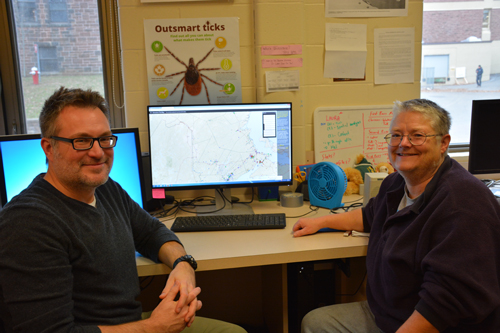Mount Allison’s Lyme Research Network launches Maritime Tick Portal
New mapping resource helps share latest information on ticks and Lyme disease in the region
 SACKVILLE, NB — Mount Allison University’s Lyme Research Network (LYRN) has released a new resource to help New Brunswickers track ticks in the region.
SACKVILLE, NB — Mount Allison University’s Lyme Research Network (LYRN) has released a new resource to help New Brunswickers track ticks in the region.
The website – maritimetickmaps.ca – allows users to explore maps of the current and projected geographic distribution of the blacklegged tick in New Brunswick. The project is a collaboration between Mount Allison biologist Dr. Vett Lloyd and Dr. David Lieske, Mount Allison geography and environment professor and director of the Geospatial Modelling Lab (GML) as part of the LYRN.
Ticks, which can carry and spread the bacteria that causes Lyme Disease and other diseases, are undergoing dramatic range shifts under the influence of climate change, and are expected to spread to many areas of the province where they are currently rare or absent.
“We’re now seeing ticks in New Brunswick throughout most of the year and in places where they were previously rare, due in part to our milder winters,” says Lloyd. “Having this kind of interactive tick map for the region helps us more easily track where ticks are most prevalent.”
To help combat the public risk ticks and the bacteria they carry bring, researchers in the Mount Allison LYRN, with the assistance of veterinarians and the public across New Brunswick have joined forces to share this mapping information showing where ticks, and Lyme disease, has been found in the province.
“The mapping project has involved students and faculty from several departments at Mount Allison,” says Dr. Lieske, whose research focuses on biogeography and climate change modelling. “This new information will give the population a better current picture of tick-distribution in the region, as well as future projections based on our current climate patterns.”
In the coming weeks, Mount Allison University will also host public information sessions in the Tantramar area to discuss the findings and demonstrate the use of the Maritime Tick Portal.
Mount Allison Lyme Research Network (LYRN), launched in May 2017, is made up of 14 Mount Allison researchers from disciplines across campus including English, geography and environment, psychology, chemistry, and biology. The collaboration helps to provide a multi-faceted approach to tick and Lyme disease research.
In addition to tick mapping, the GML at Mount Allison, under Lieske’s direction, is involved in mapping the impacts of human activity and environmental change. Current and past projects include assessing the threats facing seabirds breeding in Atlantic Canada, identifying key habitat for American Black Ducks, and visualizing coastal flood risks in the Tantramar region of southeast New Brunswick.
The Maritime Tick Portal is supported by funding from the Environmental Trust Fund of New Brunswick, the Canadian Lyme Disease Foundation, and Natural Sciences and Engineering Research Council (NSERC).
Photo caption (l-r): Mount Allison professors Dr. David Lieske (geography and environment) and Dr. Vett Lloyd (biology) in the Geospatial Modelling Lab at the University. The pair have created a new website — maritimetickmaps.ca — to help New Brunswickers track ticks in the region as part of Mount Allison’s Lyme Research Network.




